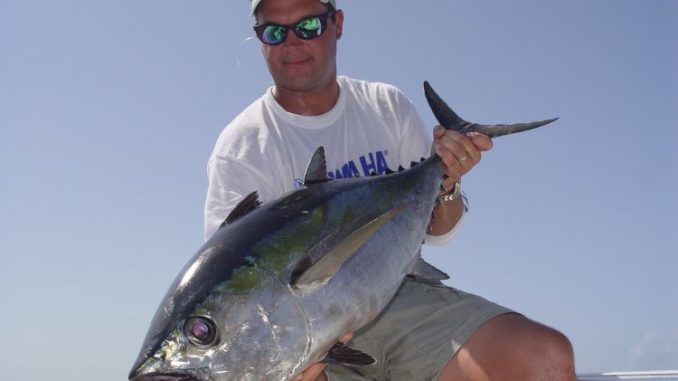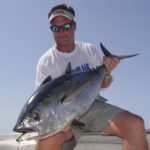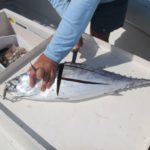
Big yellowfin may get the lion’s share of offshore glory, but blackfin tuna also put up a heckuva fight — and they taste great, too. Here’s the intel you need to make a blackfin meat haul.
From short jokes to hand-me-downs that don’t quite fit, it’s tough being the smallest kid in the family.
But you can withhold any sympathy for blackfin tuna because, despite being the smallest of the Gulf’s tuna clan (which includes bluefin, bigeye and yellowfin), these guys have no problem claiming their spot in the sport-fishing game.
Darker in overall coloration than their lemon-trimmed larger cousins, adult blackfin sport shimmering purple accents and a golden brown lateral bar. Juveniles sport similar coloration, but often with light vertical bars.
As far as sporting value, Gulf blackfin running about 18 to 25 pounds allow you to scale down from the gorilla gear needed to stop a yellowfin four to five times that size — yet still enjoy the reel-sizzle for which tuna are known.
On the dinner plate, ahi purists will probably never yield on their yellowfin preference, but for general seafood table fare, blackfin do just fine.
“I’ve always liked the blackfins,” said Capt. Mike Frenette of Venice-based Redfish Lodge. “The thing about blackfin is they’re more prevalent than the yellowfin. And when you clean both and cut it the same size, it’s hard to tell them apart.”
Capt. Hunter Caballero, of Paradise Outfitters, finds blackfin year-round throughout the Delta region, but he knows fall brings the action closer — often within 10-15 miles of the passes. The main reason, he said, is that opportunistic tuna come in to capitalize on the waves of pogies falling out of the passes.
So, what’s the best way to catch blackfin? Truthfully, anytime you can get a bait in front of one of these gluttons. But to narrow down your search…
Trawler takedown
It’s a big Gulf and blackfin tuna are one of its most ADD creatures. That means the most time-effective plan targets where the fish are most likely to congregate. Simple deal, actually — just follow the food.
If you’re thinking “bait schools,” you’re not necessarily wrong; but while tuna are fully capable of running down a meal, they’re no different than any fish in that the easy meal is always the tastiest. For the fall season, that means shrimp trawlers.
To maximize their time, shrimpers typically cull one load, while trawling for the next. Tossing their discarded bycatch overboard, along with the persistent smell of the gear, creates a massive chum line that attracts hungry tuna.
Notably, Frenette points out that if a shrimper stops to anchor and clean up, the impatient tuna will go elsewhere. Sharks and jacks might stay, but once the buffet is gone, tuna bounce to the next meal.
Bottom line, moving boats are what you want; but, as Frenette points out, this deal can be considerably more challenging than simply flipping out a couple of baits in the free chum line. On the contrary, the very premise of working with a moving target creates a challenging dynamic that can make you look silly — or worse.
“It’s not for the faint of heart,” Frenette warned. “You want to make sure you know how to handle your boat, because the shrimper’s wheel wash can spin you around — and the last thing you want to do is get tangled up in his gear.”
Divide and conquer
Caballero agreed, and uses the tuna’s appetite to his advantage. He’ll look for shrimpers as shallow as 125 feet, but normally starts around 200. Before starting his search, he’ll sling a cast net in coastal shallows to load up on fresh pogies, which he’ll use for bait and strategic chumming.
“When I pull up to a boat, I’ll chum like crazy with cut pogies to pull off a school,” Caballero says. “I want to get them 100 yards away from that boat so I don’t have to worry about getting tangled in his gear.
“You might get bonitos chummed up first, but don’t leave. Sometimes, the blackfin come up quickly, but we’ve gone 30 minutes with only bonitos and then suddenly, the blackfin show up.”
Strategy note: While the opportunity presents itself, grab a few bonito for chunk bait options. Caballero will also fish those chunks of pogie, but the bloody, oily bonito flesh can be a game-changer.
With blackfin showing in his chum line and on his electronics, he’ll drop pogy chunks on 6/0 to 8/0 3X strong Mustad circle hooks. Presentation, he said, is key.
“You always want to hide your hook,” Caballero explained. “I cut a little slit in the bait and push the hook into meat — you’re not actually hooking it. That way when the fish bites, the hook comes right out. Also, when you’re reeling in my line (for a new presentation), the bait chunk comes off so it won’t twist your line.”
To cover his options, Caballero also deploys a live hard tail about 50-100 feet down to tempt any big tuna that resist the chum. To get the bait through the bonitos, he affixes a 16-ounce weight to his leader about 20 feet above the hook with several wraps of a heavy duty rubber band.
If the tuna are hot at the surface, try topwater poppers or, as Frenette suggested, a 12-weight fly rod with a baitfish pattern. Whatever you prefer, don’t slack on the appetizers.
“You always want to have lots of chum this time of year,” Caballero said. “Some days you may go through 250 pounds of chum.”
To complement the trawler option, here are a few more productive blackfin tactics.
Rig pigs
Blackfin don’t seem to mind roaming the nearshore rigs or the deep water floaters, as long as there’s food to be had. One thing Caballero has noticed is that on those deeper rigs, blackfin tend to hold about 50 yards from the structures, basically between the trash fish zone and where you’d expect the yellowfin.
Chunking works here, but you’ll also do well by trolling large diving lures, swimbaits and the venerable cedar plugs. If he’s marking fish deep, Frenette deploy a Mann’s Stretch 25 on a downrigger.
“I rely heavily on my Raymarine Axiom Pro 12 to see what’s going on beneath the surface,” Frenette said. “The RealVision 3D imaging helps me see around the rig to find where the fish are. The clarity of that CHIRP sonar is very helpful in differentiating bait from tuna.”
Now, rigs can be every bit as productive as a shrimper, but hold off on the chumming here or you’ll be looking at one enormous jack crevalle and shark convention. You’re much better off relying on nature’s chum machine.
“I look for piles of birds and little bonito busting at the surface,” Caballero said. “When you have birds and bonitos, you’ll have tuna beneath them.”
Ups and downs
If you’re marking rig fish deep and can’t get them to come up to the chum, or if bonitos are too thick behind a shrimper, fire down a Striker Offshore Tackle Flat Fall jig, or similar blade-style jigs with dual hook harnesses. Drop the bait below the fish marks and vertically jig it through the target zone.
Remember, tuna are slashing feeders, so don’t be surprised if you feel a brief tug, then slack. Often a fish will have the jig in its mouth without being fully hooked. (This is where an optional stinger harness at the opposite end can prove helpful.) Nevertheless, if a fish hits and drops your jig, immediately return to your jigging motion.
However you choose to engage blackfin, know that they’re just not gonna give up anytime soon. Not as much horsepower as a big yellowfin, true; but don’t be fooled by the more manageable size — these fish have plenty of gas in the tank.
Caballero tackles blackfin with a 6-foot, 6-inch Penn Ally Rod with a size 20 Penn conventional reel packed with 5- to 600 yards of braid backing a topshot of 80-pound monofilament, terminating with a 25 feet of fluorocarbon. Some days call for light leaders, but Caballero stresses the importance of starting off loaded for bear.
“I like 80- to 100-pound fluoro because there could be a big yellowfin mixed in with the blackfin,” he said. “On days when I’m not getting many bites, I may downsize to 50-pound fluoro, but I don’t like to start that size.
“When a fish wants to run, never try to stop him, don’t yank on him. On the initial run, back off the drag, let the fish make a big run, then tighten the drag and get on him from there.



